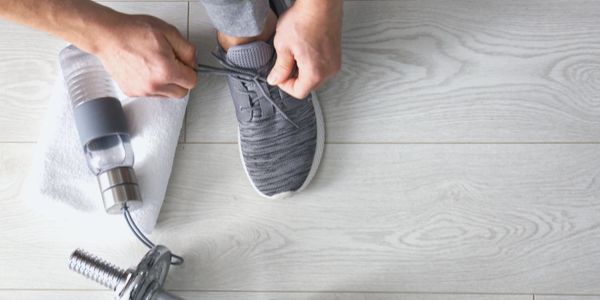
Whether weight loss or fitness-related, plateaus can be frustrating. A plateau in fitness can occur when, even when you diligently workout, fitness gains halt. While this halt in progress can be frustrating, the good news is there are ways to get through a fitness plateau.
Are you staying consistent with workouts but stopped seeing results? Do not throw in the towel! Here are 5 reasons you may have hit a fitness plateau and how to get through it.
5 Steps to Get Through a Fitness Plateau
Not getting faster, stronger, or leaner through your workouts as you once were? You may be going through a fitness plateau. These 5 steps can help get you out of a flat line and reemerge workout progress.
1. Reassess Your Goals
First, ask yourself if you are really experiencing a fitness plateau or if your goals may be too lofty or unrealistic. Of course it is admirable to dream big but expecting monumental results in a short bit of time may leave you feeling defeated. Are your goals reasonable?
Start by identifying exercises that you enjoy - you are more likely to stick to an activity you find gratifying than attending workouts you dread. For instance, if you dislike running, signing up for a race may not be the best fitness goal for you.
Making SMART - specific, measurable, achievable, realistic, and timely - goals is a proven way to meet goals. SMART goals continually show to increase the greatest compliance. So rather than saying "I will complete 20 pull-ups," if you have yet to master your first, create a SMART goal such as "I will workout 3 days a week for 4 weeks.”
Even if a beginner, a 4 week workout plan for 3 days a week is doable and will challenge you.
2. Change Up Your Workouts
One of the greatest advantages of the body is its ability to acclimate. Well, unless you are trying to lose weight or build muscle mass…
When you are continually performing the same exercises session after session, eventually the body learns to handle the stressors. Muscles likewise start memorizing movements and perhaps are not effective as they once were.
For example, instead of always doing squats in a structured exercise program, switch the movement to lunges. While lunges still target the lower half of the body, you are now targeting muscle groups at different angles.
High-intensity interval training, better known as HIIT or tabata exercise, is another plateau workout to give a try. HIIT is when the body works very hard for about 30 to 60 seconds then recovers for twice that long. This type of aerobic exercise tends to boost the metabolism and help speed up fat loss.
Also, make fun, new goals to help motivate the process and reduce the risk of potential boredom. Wanting to run a 5K? What about accomplishing that first pull-up? Now is the time to reach such goals!
3. Get Adequate Rest
More is not always better, especially when it comes to exercising. In fact, overtraining and overworking the muscles and body can stall and even prevent any noticeable improvements.
Because the truth of the matter is, that recovery is just as essential as the workout itself. How?
During strenuous exercise, muscle tissues breakdown. And in order to rebuild, recovery grants the opportunity for muscles to build, all while preventing the risk of injury. Working out while sore or sick could potentially delay fitness gains and may result in further illness or injury.
According to the American Council of Exercise, common signs of overtraining include:
• Decreased performance
• Increased perceived effort during workouts
• Excessive fatigue
• Insomnia or restless sleep
• Loss of appetite
• Chronic or nagging injuries
• Psychological stress
If these symptoms sound familiar, not enough rest could be the result of your workout plateau. Fortunately, there are ways to beat through this fitness plateau and lower the risk of developing overtraining signs.
Start by giving the body the rest and recovery it needs to safely and effectively reach the results you are working towards. Allow for “rest” days at least a couple of times each week.
If feeling the hankering for a workout, participate in active recovery. This might be through a leisurely walk, yoga, or any other activity that is lower in intensity and volume compared to routine workouts.
Also, pay attention to your body. If it feels overly exhausted, rather than forcing a strenuous workout, give it the rest it is yearning for.
And do not forget the importance of sleep! Inadequate sleep impedes muscle recover, lowers the energy needed to carry out workouts, and heightens sensations of hunger.
4. Find Accountability
Of course, you can exercise and reap the anticipated results. However, sometimes it is important to consult and accept the assistance of a personal trainer.
Personal trainers are knowledgeable in creating effective fitness routines for individualized goals. They also help ensure exercises are being completed in a safe fashion.
If having a personal trainer is not available to you, find a workout buddy to still give accountability for workouts. Working out with someone can help motivate and push you more than just exercising on your own. They can also inspire new exercises to try!
5. Focus on Your Food
Just as continuously doing the same repetitive movements, eating the same caloric value and monotonous diet can halt progress.
Especially if weight loss is the motivating factor, there is much truth to the statement, “You cannot outrun a poor diet.” On the other hand, underfueling can cause the body to hold onto the calories it is offered. And if looking to gain muscle, you may not be consuming enough protein and calories necessary to build it.
Nutrition recommendations vary based on goals, including whether you want to maintain, lose, or gain it. But whatever the motivating factor, journaling food intake and placing the focus on whole grains, vegetables, fruits, lean and plant-based proteins, and healthy fat sources can be helpful.
Much like a personal trainer, a dietitian can help create a personalized plan to address needs, guide beneficial pre and post-workout foods, and help you reach personal goals! A meal delivery service can also help ensure nutritional needs are being met during your health journey.
Breaking a Workout Plateau Recap
Hitting a fitness plateau can be frustrating because you are no longer seeing the physical gains from exercise as before. In order to break out of a fitness plateau, try re-assessing your goals.
Do you have an attainable fitness goal? Are you allowing yourself enough time to reach your goal? Are you training, resting, and eating properly?
Having accountability and changing up workouts can also help you break a workout plateau. Each of these steps can spur creativity and new ways to challenge your muscles instead of the same, monotonous workout patterns.







